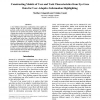Free Online Productivity Tools
i2Speak
i2Symbol
i2OCR
iTex2Img
iWeb2Print
iWeb2Shot
i2Type
iPdf2Split
iPdf2Merge
i2Bopomofo
i2Arabic
i2Style
i2Image
i2PDF
iLatex2Rtf
Sci2ools
AAAI
2015
2015
Constructing Models of User and Task Characteristics from Eye Gaze Data for User-Adaptive Information Highlighting
A user-adaptive information visualization system capable of learning models of users and the visualization tasks they perform could provide interventions optimized for helping specific users in specific task contexts. In this paper, we investigate the accuracy of predicting visualization tasks, user performance on tasks, and user traits from gaze data. We show that predictions made with a logistic regression model are significantly better than a baseline classifier, with particularly strong results for predicting task type and user performance. Furthermore, we compare classifiers built with interface-independent and interface-dependent features, and show that the interface-independent features are comparable or superior to interface-dependent ones. Finally, we discuss how the accuracy of predictive models is affected if they are trained with data from trials that had highlighting interventions added to the visualization.
| Added | 27 Mar 2016 |
| Updated | 27 Mar 2016 |
| Type | Journal |
| Year | 2015 |
| Where | AAAI |
| Authors | Matthew Gingerich, Cristina Conati |
Comments (0)

